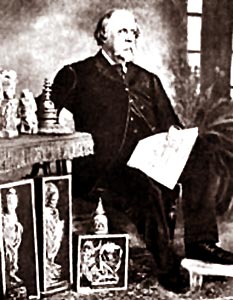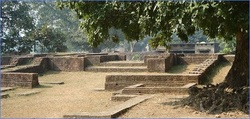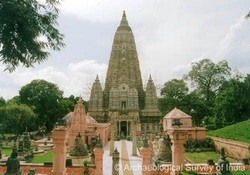By the turn of nineteenth century, Buddhism was all but gone from the land of its birth. This article describes how archeology helped resurrect the buried mounds of evidence and lists a few places connected with Buddha's life.

Alexander Cunningham
"Discovery" of Buddhism
Buddhism disappeared in India in the 11th century, due to the many invaders who destroyed thousands of monuments. The Buddha was all but forgotten in the land of his birth.
Buddhism was rediscovered owing to the work done by government-sponsored Archaeological Survey of India, founded in 1871. Alexander Cunningham, the first Director-General, brought Buddhism to the forefront and established its study as a separate discipline.
Assisting Cunningham in his archaeology work were the accounts left by two Chinese monks: Fa Xian’s Record of Buddhist Countries in the 1840s and Xuanzang’s Record in the 1850s. Between the two of them, they had mapped out the whole of Buddhist India, with all the main sites, their locations, their importance, their histories, and details of the monasteries and the monks who inhabited them.
Buddhism disappeared in India in the 11th century, due to the many invaders who destroyed thousands of monuments. The Buddha was all but forgotten in the land of his birth.
Buddhism was rediscovered owing to the work done by government-sponsored Archaeological Survey of India, founded in 1871. Alexander Cunningham, the first Director-General, brought Buddhism to the forefront and established its study as a separate discipline.
Assisting Cunningham in his archaeology work were the accounts left by two Chinese monks: Fa Xian’s Record of Buddhist Countries in the 1840s and Xuanzang’s Record in the 1850s. Between the two of them, they had mapped out the whole of Buddhist India, with all the main sites, their locations, their importance, their histories, and details of the monasteries and the monks who inhabited them.
One such Buddhist site uncovered by Cunningham is at Sarnath, the spot of the Buddha’s first sermon after his enlightenment. The Mahabodhi Temple as we see it today in Bodh Gaya was restored by him. Another of his discovery is the spot where Buddha died. Under his supervision, the statue of reclining Buddha picturing the Nirvana was found amidst stupas exactly as Xuanzang had described it 1,200 years before.
Helping to tie up the information about Buddhism were the hundreds of stupas that were excavated at various sites. These carried inscriptions, most important of which were the Ashoka's edicts. Ashoka gave up military conquest to undertake Dharmavijaya — victory by righteousness and truth, and provided royal patronage for the propagation of Buddhism both within and beyond his empire, into Asia and Greece.
Helping to tie up the information about Buddhism were the hundreds of stupas that were excavated at various sites. These carried inscriptions, most important of which were the Ashoka's edicts. Ashoka gave up military conquest to undertake Dharmavijaya — victory by righteousness and truth, and provided royal patronage for the propagation of Buddhism both within and beyond his empire, into Asia and Greece.
Important Places Associated With Buddhism in India/Nepal

- Kapilavastu/Piprahwa where Buddha was born
Generally, Indian guidebooks consider today's Piprahwa village (110 km north of Gorakhpur in Uttar Pradesh) to be the real Kapilavastu, while Nepalese guidebooks consider Tilaurakot to be the real Kapilavastu. Buddha spent 29 years of His early life in Kapilavastu and Lumbini.

Mahabodhi Temple
- Bodh Gaya in Bihar State where Buddha achieved Enlightenment
Mahabodhi temple is located on the Phalgu River, a tributary of the Ganga, 182 kilometres south of Patna, the capital of Bihar. Constructed by Ashoka, the temple houses the Bodhi Tree (Ficus religiosa) under which Siddhartha attained Enlightenment and became Buddha.
Today the area within one kilometre of the Mahabodhi temple is dotted with several monasteries, such as the Indosan Nipponji Japanese Temple, which houses a Buddha image, at least three Tibetan monasteries, and a number of houses of worship maintained by Sri Lankan, Bhutanese, Chinese, Vietnamese and Nepalese monks.
- Sarnath in Uttar Pradesh, where Gautama Buddha delivered his first sermon to five disciples
Read More
 RSS Feed
RSS Feed